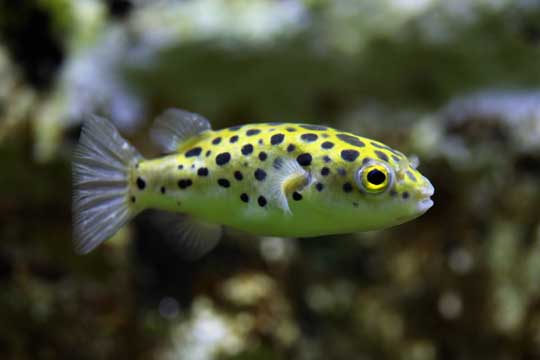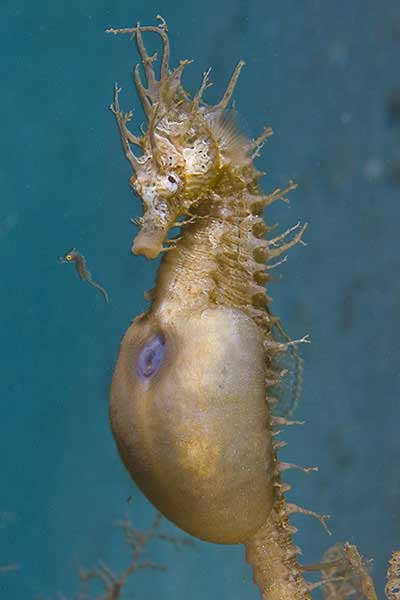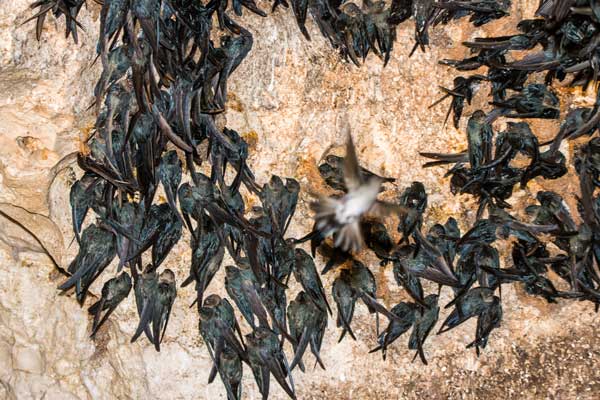|
Did you know giraffes are the tallest land animals in the world? A giraffe's legs, at 6 feet (1.8m) tall, are taller than most people. And that neck! The neck alone is another six feet. Put all this height together, along with the height of the body, and male giraffes stand almost 19 feet (5.8 m) tall. This gives them access to yummy leaves that are out of reach for most other African herbivores. Acacia leaves are their favorites. Acacias have nasty thorns, but giraffes can use their incredible, 18-inch (46 cm) tongues to grab the leaves without getting prickled. Giraffes eat about 75 pounds (34 kg) of leaves per day to fuel their massive bodies.
Being the tallest animal has its challenges. For example, pushing blood all the way up to a head that's almost in the stratosphere requires a massive heart with thick, muscular walls. The giraffe's heart is 2 feet (61 cm) long and weighs 25 pounds (11 kg). Um... a 25-pound heart is the size of 50 human hearts. There is also the problem of getting a drink of water. To get their mouth to the surface of a pond or stream, giraffes have to spread their front legs wide in an awkward position. This position makes them vulnerable to predators, so it's a good thing (for the giraffe) they only need to drink once every few days. They get most of the water they need from the leaves they eat. They spend so much time eating that they sleep only 5 to 30 minutes per day, broken up into 1-to-2-minute naps, which they often do standing up. There's also the problem of giving birth. Giraffes do everything standing up, including giving birth. This means that a giraffe calf's first experience out in the world is a five-foot fall onto the ground! Welcome to your life, kid. Here's something that will blow your mind. Even with that 6-foot neck, giraffe's only have seven neck vertebrae, the same number that humans have. Each giraffe neck bone is about twenty times longer than a human neck bone.
0 Comments
Awesome Animal Fact:
Did you know whales are the loudest animals on Earth? In a previous post I explained that an insect called the water boatman is the loudest animal for its size. But what about the loudest animal overall, looking only at pure decibels? Well, the answer isn't that straightforward... it could be the blue whale, or it could be the sperm whale, depending on how you look at it. I'll explain. In pure decibels, the blue whale can produce sounds at an amazing 180 decibels. For reference, a jet engine is at a deafening 140 decibels. In humans, prolonged exposure to any sound over 85 decibels results in hearing loss. So, the blue whale is really loud. However, the sperm whale has been shown to create sounds at 233 decibels, the loudest sound ever measured from any animal. So, why isn't the sperm whale the clear winner? Because the intensity of a decibel is dependent on how we perceive the sound, relative to its frequency measured in hertz. In humans, our hearing threshold is different for sounds of different frequencies. Blue whales make low, drawn-out moans that can travel up to 1,000 miles (1,600 km) under water. In contrast, sperm whales make brief clicks, used for echolocation. This echolocation ability is impressive, sometimes detecting squid up to a mile away, but the sounds don't travel nearly as far as blue whale moans. A blue whale's calls are low frequency, only 20 hertz, so low that humans can't even hear the sounds until they get above 70 decibels. A sperm whale's clicks are at a much higher frequency, at 10,000 hertz, and humans can hear them at only 15 decibels. Not only that, blue whale moans last 20 to 30 seconds, whereas sperm whale clicks last only 100 microseconds. Below is a sperm whale. Did you know the grey-headed albatross can circle the globe in only 46 days? British scientists attached sensors to 47 grey-headed albatrosses, then they were able to recapture 22 of the birds when they returned to their breeding area 18 months later. The scientists examined the data, which told the detailed story of the birds' travels. Some of the birds stayed in the area, but 12 of them headed east and circled the entire globe. Amazingly, three of them circled the globe twice!
The fastest circumnavigation was 46 days. That's 14,000 miles in only 46 days! The typical daily flight for the birds was 600 miles. This information could be important in helping governments around the world develop conservation strategies for albatrosses. After all, 19 of the 21 species are threatened with extinction. Did you know pufferfish, although extremely cute, are also extremely poisonous? Pufferfish, as well as several related fish, contain tetrodotoxin, one of the most toxic poisons found in nature, 1,200 times more toxic than cyanide. One pufferfish can contain enough of this toxin to kill 30 adult humans.
In case you aren't familiar with pufferfish, they are those cute, pudgy fish that blow up like a water balloon when threatened. Their shape makes them rather sluggish swimmers, so they are vulnerable to predators. At least they would be if it weren't for their inflatable ability and the tetrodotoxin in their bodies. If a predator grabs a pufferfish, the pufferfish will inflate and become difficult or even impossible to swallow. If the predator manages to grab the pufferfish before it inflates, the predator will probably soon regret its mistake when the toxin kicks in. Not only does the toxin taste really bad, it is deadly to other fish. So, if you think about it, when the pufferfish inflates and becomes impossible to swallow, it not only saves its own life, it also saves the predator's life. Surprisingly, pufferfish meat is a very expensive delicacy in Japan, where the meat is called fugu. It is only prepared in certain restaurants by trained and certified chefs, who understand that making one wrong cut on the fish could be deadly to their customers. In spite of this, more than 100 people die each year from eating improperly prepared pufferfish. In many restaurants, the sushi chefs are required to taste the fugu they have prepared before serving it to customers. Awesome Animal Fact:
Did you know the loudest animal, for its size, is the water boatman? One particular species of water boatman (Micronecta scholtzi), only about the size of a grain of rice, at 2 mm long, is capable of making the loudest sound relative to body size. Scientists measured the volume of the water boatman's "song," even though the insect only sings underwater. They determined that these rowdy little critters can sing at 105 decibels, which is about as loud as a jackhammer pounding the concrete right next to you. A person can hear this sound standing at the edge of a pond where a boatman is singing at the bottom of the pond. The sound is produced below water, but most of the volume is lost when the sound crosses from water to air. This is probably a good thing for those of us who like the peacefulness of nature. In case you're wondering how they make this sound, the male water boatman, in its attempts to attract females, rubs its penis against its abdomen. Kind of like how crickets make a ruckus by rubbing their wings together, except the water boatman uses its male sex organ instead. Will wonders never cease? Awesome Animal Fact: Did you know baby seahorses develop inside the body of the adult male seahorse instead of the adult female? Seahorses (as well as the related pipe fishes and sea dragons) are the only known animals in which the males give birth to the young. How does this work, you ask? Here's the process. It starts with an elaborate courtship "dance" that sometimes lasts hours or even days. Generally, such courtship behaviors accomplish two things: to make sure the desired mate is the same species (this is the reason species that look similar have different courtship displays), and to determine if the prospective mate is a worthy mate. Once the courtship dance has served its purpose, the female seahorse deposits her eggs into the male's brood pouch. He then fertilizes the eggs inside his brood pouch. As the embryos grow, the male's abdomen becomes distended, just like a human female's abdomen during pregnancy. When it's time for birth, the male's abdomen opens, and contractions squirt the babies out into the water. Male seahorses give birth to as many as 1,000 babies at a time. Why so many? Because life in the sea is harsh, and few of the babies survive to become adults. We don't know for sure why seahorses have this reversal of gender roles, although one explanation is that this frees up the female to almost immediately form a new brood of eggs for another male, thus increasing her reproductive output. Below is a male seahorse popping out the first of many babies. Photo Credits: - Male seahorse giving birth - "seahorse baby" by jidanchaomian is marked with CC BY-SA 2.0. Awesome Animal Fact:
Did you know the oilbird is the loudest of all the birds? You probably wouldn't want to be in a cave when a group of oilbirds fly into the cave to roost. Oilbirds, like bats, use echolocation to find their way around in caves that are totally dark. Bats, however, use a call that is outside the human range of hearing. But oilbirds? Nope, not so much. Oilbird echolocation calls are perfectly audible to humans, and at close range can be up to 100 decibels. Try to imagine a whole swarm of them flying about in a cave all at once. Some colonies include thousands of birds! Why are oilbirds so loud? Well, as I said, bats use echolocation to navigate in caves and to catch their insect prey outside of caves. Oilbirds, on the other hand, only use echolocation to navigate caves, not to catch their insect prey. This is probably because their echolocation sensitivity is relatively low—they aren't very good at it. In fact, scientists have found that they fly headfirst into plastic discs that are 4 inches (10 cm) in diameter, but they are able to avoid discs that are 8 inches (20 cm) in diameter. If they can't avoid a 4-inch disc, they definitely can't use echolocation to catch insects that are much smaller than 4 inches. Bats, on the other hand, can echolocate the tiniest of flying bugs. So, perhaps oilbirds have such loud calls to make their poor echolocation work at least well enough to avoid smacking into the walls of their cave. Below are oilbirds clinging to the wall of their roosting cave. Did you know octopuses have three hearts and nine brains? (by the way, octopuses is the preferred plural, not octopi)
First let's consider the hearts. Octopuses have evolved this three-heart system as a result of living in deep areas of the ocean where oxygen is scarce. The three hearts help get oxygenated blood to all parts of the body. Two of the hearts pump blood to the gills, where the blood picks up dissolved oxygen. The third heart, the largest, pushes the oxygenated blood to all parts of the body, including the tips of those eight tentacles. Okay, what about the nine brains? Octopuses have one centralized brain. Oddly, this brain is in the shape of a doughnut, and it is arranged around the esophagus. The food they eat actually passes through the hole in the brain (uh... food for thought?). This brain, like a human's brain, controls many of the overall body functions. But what about the other eight brains? Have you ever watched an octopus move around? Those eight tentacles are constantly moving independently of each other, often with complex movements. What makes this possible is that each of the tentacles has its own brain, a complex bundle of nerves called a ganglia. Here's an example of how that helps an octopus. Let's say the main brain tells the body to go check out a coral rock for a possible crab to eat. No problem. But then those eight arms start probing the coral, each of them reaching in a different crevice, feeling around for a snack. That requires a great deal of brain power, but the mini-brain in each tentacle allows the tentacle to act almost like an individual entity as it searches for food. |
Stan's Cogitations
Everyone needs a creative outlet. That's why I write. Archives
July 2024
|









 RSS Feed
RSS Feed